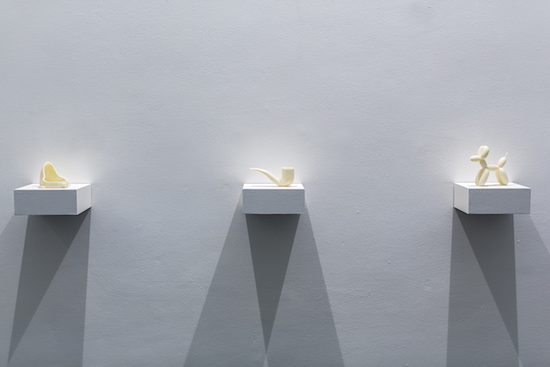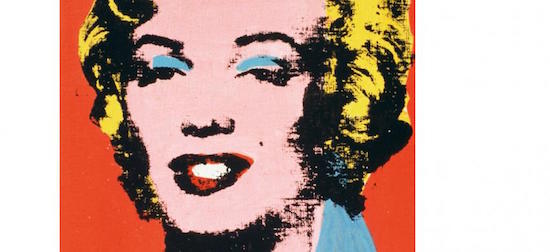No doubt you recognise the image up there, above this line of text. It’s a Warhol, right? Of course it is. One of the fifty odd screen prints the Pennsylvanian pop artist produced from a single publicity still of Marilyn Monroe between August 1962 and September 1964, it’s become one of the most iconic and recognisable images in all modern art. Who could mistake it? Well, yes, except – no, actually.
This image is not a Warhol at all. It’s a Sturtevant. And as a Sturtevant, it plays on precisely this immediate sense of brand recognition that leads people to identify it – immediately, unthinkingly, but incorrectly – as a Warhol.
Born in 1924, in a town not far from Cleveland, Ohio, by the late 1950s Elaine Sturtevant was living in New York, painting, and hanging out with the likes of Robert Rauschenberg and Jasper Johns. In 1965, she held her first solo show, at the Bianchini Gallery on the Upper East Side, exhibiting a series of works which uncannily resembled other works like Warhol’s Flowers series, a Jasper Johns flag, a Frank Stella painting, a George Segal sculpture. In later years she produced works after works by Anselm Kiefer, Paul McCarthy, and Félix Gonzáles-Torres.
But these were not forgeries, nor were they copies. Feted by the 1980s generation of appropriation artists, Sturtevant would explicitly set her intentions apart from those of Sherrie Levine and her contemporaries. As Rauschenberg would say of one of her Jasper Johns Flags, such works represent “an original flag in the manner of Jasper Johns.”
A new book in Afterall’s essential One Work series examines the life and work of this most curious of conceptual artists, zeroing in on her first Warhol Marilyn, from 1965, in particular. Written by the writer and academic Patricia Lee, the book joins previous Afterall texts dedicated to Mike Kelley, Rodney Graham, Philip Guston, and others. In advance of its release, Lee sat down with UCL art history professor Briony Fer in the lecture hall of Central Saint Martins to discuss the book.
“I don’t think she ever set out,” Lee said to the crowd of art students assembled in the lecture theatre off Granary Square, “to make an exact replica.” There is an almost studious infidelity to the results of Sturtevant’s recreations, even while the processes of their production may be rigorous in the extreme. For her Warhol Flowers, Warhol himself lent her the very screen he had used to print from. In the case of her Warhol Marilyn, the original screen was lost but Sturtevant successfully tracked down the original publicity still that it was made from and took it to Andy’s own silkscreen guy to make the stencil. In later years, when people asked Warhol how he made his silkscreens he would simply answer, “Ask Elaine.”
“Everyone says, ‘So, Andy really understood!’” Lee quotes Sturtevant in the book, “Well I don’t think so. I think he didn’t give a fuck. Which is a very big difference, isn’t it?”
I had been thinking about Sturtevant ever since visiting a group show at south London’s Jerwood Space back in January. Curated by Hannah Pierce, ‘Common Property’ featured an installation composed of One Direction fan fiction by Owen G. Parry, paintings by Edwin Burdis that purport to apply the DJ techniques of “sampling” and “remixing” to a visual realm of acrylic paint and spray cans, and videos by Antonio Roberts created by transforming the code behind mp3s to songs – like ‘Blurred Lines’ and ‘My Sweet Lord’ – famous for their part in legal copyright wrangles.
One of the most intriguing works in the show was also, perhaps, the most unassuming. On a shelf, just by the entrance, sat three small off-white object, each one no more than about 15 cm across. Despite their bland, smooth surfaces, these objects were as immediately identifiable, as iconic in their way, as a Warhol Marilyn: a pipe, a balloon dog, and a urinal.

Rob Myers’ ‘Shareable Readymades’ from Jerwood Visual Arts’ Jerwood Encounters: Common Property show earlier this year. Photographer: Hydar Dewachi
Rob Myers is a British artist, based in Vancouver, who has been making art pertaining to remix culture since the 1990s. In 2005 he held the world’s first ‘copyleft’ solo show. His work continues to explore issues around property rights with, more recently, a new interest in 3D printing. His Shareable Readymades take the form of signature works of famous artists – Matisse’s pipe, Jeff Koons’s puppy, Duchamp’s ‘fountain’ – and renders them as downloadable, freely licensed 3D-printable models to circulate, proliferate, and multiply as easily as the ideas they embody.
Sturtevant herself made several works after works by Duchamp. She tended to favour artists who in some way disturbed traditional notions of authorship. At the time Sturtevant first started making her works of works, Duchamp – as Briony Fer and Patricia Lee pointed out at the St. Martins lecture – had just started authorising copies of his fountain (the ‘original’ being now long gone). Unlike Sturtevant’s works of works, of course, it makes little sense to speak of the open source 3D-printed fountain at Jerwood as an ‘original’. Like Duchamp’s own readymades, they resemble more Baudrillard’s simulacra – copies without originals, (bit)maps without a territory.
Sturtevant always refused to be “jammed into [any] category”. Her work was never simply a case of ‘appropriation’. But I suspect she would have been intrigued by Myers’ Shareable Readymades. She spoke often of cybernetics in the 60s and later warmly embraced digital media. “What is currently compelling,” she said, “is our pervasive cybernetic mode, which plunks copyright into mythology, makes origins a romantic notion, and pushes creativity outside the self. Remake, reuse, reassemble, recombine—that’s the way to go.”
Oddly, when you think about Sturtevant’s method in a musical context, it’s not so much samplers, remixers, and filesharers that come to mind, but Billy Childish. Think of Sturtevant tracking down Warhol’s own screenprint guy – or in another famous story, sourcing the precise make of black paint used by Frank Stella, isn’t this precisely Childish’s reverent search for the valve amps and vintage guitars used by the garage rockers he makes works after the works of? There is a difference, of course. For Childish has arranged his entire career, his whole mythos, in opposition to conceptual art and its supposed decadence. His is a quest for authenticity, with little to set it apart from any other fawning fanboy. But Sturtevant thinks.
When Patricia Lee contacted Sturtevant’s estate about gaining access to some of her ‘original’ works, she was surprised by the response. “It’s not really important to see the originals,” they said. But Lee is clearly fascinated by the actual material surface of these works, each with their minor unique differences from each other, and from the works they are based upon, giving the lie to the very possibility of any such thing as a ‘copy’ in the first place. Hers is a conceptual art that manages a rigorous critique of the artist and his aura without sacrificing the allure of the thing. “The object,” Lee concludes, “is important – but it’s not important.”
Patricia Lee’s book Sturtevant Warhol Marilyn is released by Afterall Books


